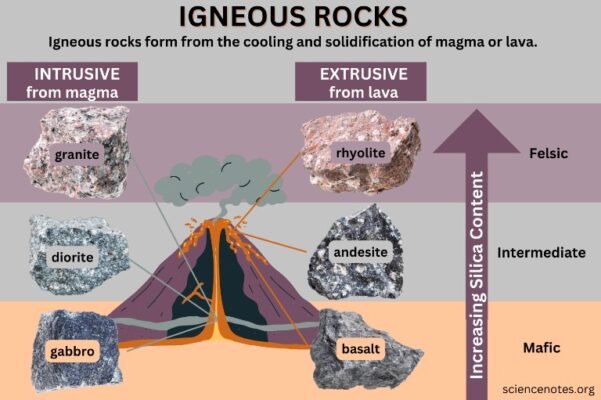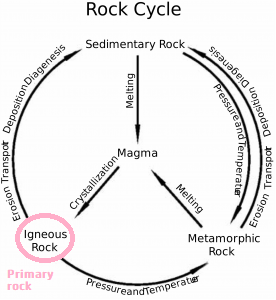Primary rocks, also known as igneous rocks, are formed from the solidification and cooling of molten magma or lava. These rocks are considered “primary” because they are the first type of rock to form in the Earth’s crust, originating directly from the Earth’s internal heat. The characteristics and types of igneous rocks depend on how and where the magma or lava cools and solidifies.
Characteristics of Primary (Igneous) Rocks
- Origin from Magma or Lava:
- Magma is molten rock beneath the Earth’s surface, while lava is magma that has reached the Earth’s surface.
- Igneous rocks form when this magma or lava cools and solidifies.
- Texture:
- The texture of igneous rocks depends on the cooling rate:
- Coarse-Grained (Phaneritic): Slow cooling beneath the Earth’s surface allows large crystals to form, giving the rock a coarse texture.
- Fine-Grained (Aphanitic): Rapid cooling at or near the surface leads to smaller crystals, producing a fine-grained texture.
- Glassy: Extremely rapid cooling can result in no crystal formation, giving the rock a glassy appearance (e.g., obsidian).
- Porphyritic: A mixture of both coarse and fine crystals, indicating two stages of cooling.
- The texture of igneous rocks depends on the cooling rate:
- Mineral Composition:
- Igneous rocks are composed of various minerals, primarily silicate minerals. The mineral composition determines whether a rock is felsic, intermediate, mafic, or ultramafic.
- Felsic: High in silica (quartz, feldspar), light-colored.
- Mafic: Lower in silica, rich in iron and magnesium, dark-colored.
- Intermediate: A balance between felsic and mafic components.
- Igneous rocks are composed of various minerals, primarily silicate minerals. The mineral composition determines whether a rock is felsic, intermediate, mafic, or ultramafic.
- Crystalline Structure:
- Igneous rocks are generally crystalline, meaning they are composed of interlocking crystals of different minerals.
- Lack of Fossils:
- Since igneous rocks form from molten material, they do not contain fossils, which are found in sedimentary rocks.
- Hardness and Durability:
- Due to their mineral content and crystalline structure, igneous rocks are usually hard and resistant to weathering and erosion.
Types of Primary (Igneous) Rocks

Igneous rocks can be classified based on where they form and their chemical composition:
Based on Formation Location:
- Intrusive (Plutonic) Igneous Rocks:
- Formation: These rocks form from magma that cools slowly deep beneath the Earth’s surface.
- Texture: Coarse-grained due to the slow cooling process, which allows large crystals to grow.
- Examples:
- Granite: A felsic rock, light-colored, rich in quartz and feldspar.
- Diorite: An intermediate rock, with a mix of light and dark minerals.
- Gabbro: A mafic rock, dark-colored, rich in pyroxene and olivine.
- Extrusive (Volcanic) Igneous Rocks:
- Formation: These rocks form when lava cools rapidly on the Earth’s surface.
- Texture: Fine-grained or glassy due to the rapid cooling, which limits crystal growth.
- Examples:
- Basalt: A mafic, dark-colored, fine-grained rock commonly found in oceanic crust.
- Rhyolite: A felsic, light-colored rock with a fine texture, similar to granite in composition but extrusive.
- Obsidian: A volcanic glass formed from extremely rapid cooling, with a smooth, glassy texture.
- Pumice: A frothy volcanic rock with a lightweight, porous structure, formed from gas-rich lava.
Based on Chemical Composition:
- Felsic Igneous Rocks:
- Characteristics: High silica content (over 65%), light-colored, rich in quartz, feldspar, and mica.
- Examples: Granite (intrusive), Rhyolite (extrusive).
- Intermediate Igneous Rocks:
- Characteristics: Moderate silica content (55-65%), a balance of light and dark minerals.
- Examples: Diorite (intrusive), Andesite (extrusive).
- Mafic Igneous Rocks:
- Characteristics: Low silica content (45-55%), dark-colored, rich in iron and magnesium, containing minerals like pyroxene, olivine, and amphibole.
- Examples: Gabbro (intrusive), Basalt (extrusive).
- Ultramafic Igneous Rocks:
- Characteristics: Very low silica content (less than 45%), dark or greenish, composed primarily of olivine and pyroxene, often found in the Earth’s mantle.
- Examples: Peridotite (intrusive), Komatiite (extrusive, rare).
Summary
- Primary (igneous) rocks form from cooling and solidification of magma or lava.
- They are classified based on their formation location as intrusive or extrusive, and by their chemical composition into felsic, intermediate, mafic, or ultramafic.
- These rocks are hard, crystalline, and devoid of fossils, with textures ranging from coarse to fine or glassy, depending on the cooling rate.


